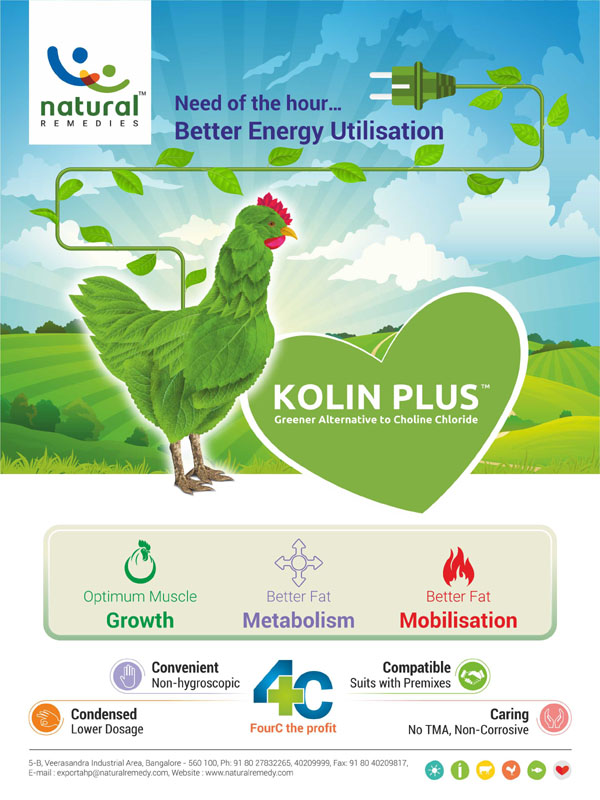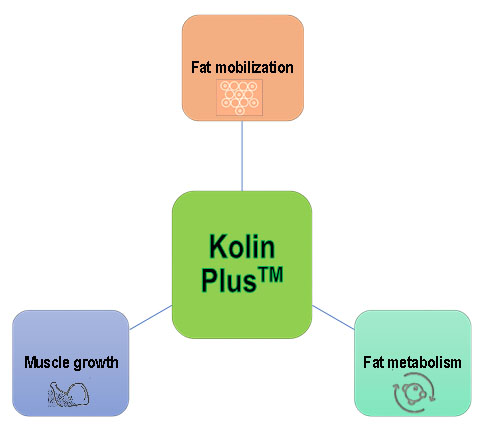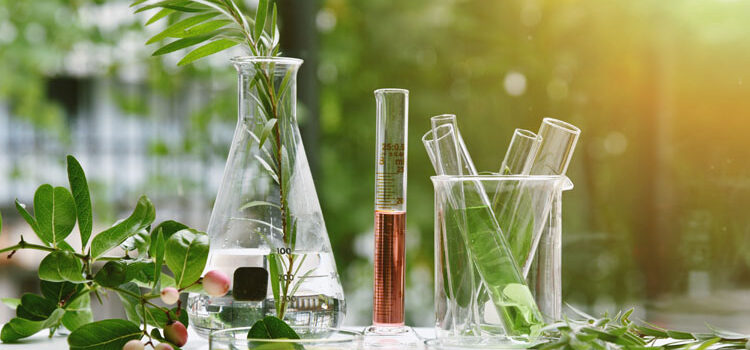The Ultimate Poultry Care – Natural Remedies’ Kolin Plus is a greener alternative to choline chloride. It aids fat mobilization, fat metabolism and muscle growth!
Choline is a vital micronutrient essential for the growth and production of the swine and poultry birds. It plays various roles like lipid metabolism and transport, neurotransmission, phosphatidylcholine synthesis, donor of methyl group etc.

Marketing Manager
Natural Remedies Pvt Ltd
As birds are inefficient in synthesizing adequate amount of choline, their diets need to be supplemented with this nutrient. Choline chloride 60% (CC 60%) is a synthetic feed additive widely used in the ration of the swine and birds, although, it exerts many disadvantages like low absorption rate, interaction with other nutrients, production of trimethylamine (TMA) in gastrointestinal (GI) system of the birds causing respiratory distress, raising feed cost etc.

KOLIN PLUS is a greener replacement of Choline Chloride 60% manufactured by M/s Natural Remedies Pvt Ltd, Bengaluru, India. Several experimental models in poultry birds corroborated the efficacy of KOLIN PLUS in enhancing the broiler performance. In an artificially induced choline deficient (CD) model, the Cobb birds were randomized into four groups viz. i) Normal control (1206 ppm intrinsic choline), ii) CD (1036 ppm intrinsic choline), iii) CD + CC 60% (choline deficient + choline chloride 60%) and iv) CD + KOLIN PLUS (choline deficient + KOLIN PLUS). The induced CD model was developed by replacing a part of soyabean meal of broiler diet by soya protein isolate. The study result showed that KOLIN PLUS reversed the negative performance induced by CD diet as that of CC 60% in broilers (Table 1).

In addition, a standard model of natural choline deficiency model was utilised wherein the Ross broilers were allotted into 3 groups viz. Normal control (N), N + Choline chloride (CC) 60% and N + KOLIN PLUS. The birds of Normal control group were fed ration without choline supplement. The study outcome exerted that addition of KOLIN PLUS in the diet of the broiler birds having natural choline deficiency improved the body weight and feed conversion ratio (FCR) as equivalent with the CC 60% supplemented group (Table 2).

KOLIN PLUS shows evidence for improved performance in both artificially induced and natural CD models. It may be due to its significant role in fat metabolism, mobilization, and optimum muscle growth. Further, it is as effective as the feed additive CC 60% even at lower dosage than CC 60% in case of both poultry and swine. Hence, KOLIN PLUS is cost effective and offers better feed economics. Moreover, it is bioavailable, compatible, non-corrosive and safe. Hence, it is an appropriate replacement of synthetic CC 60% in swine and poultry ration.

References 1. Selvam R, Saravanakumar M, Suresh S, Chandrasekeran C V., Prashanth D. Evaluation of polyherbal formulation and synthetic choline chloride on choline deficiency model in broilers: Implications on zootechnical parameters, serum biochemistry and liver histopathology. Asian-Australasian J Anim Sci. 2018;31(11):1795-1806. doi:10.5713/ajas.18.0018. 2. Parsons CM, Leeper RW. Choline and methionine supplementation of layer diets varying in protein content. Poult Sci. 1984;63(8):1604-1609. doi:10.3382/ps.0631604. 3. D’souza, P., & Selvam, R. (2022). Evaluation of polyherbal formulation in broilers fed high energy diet: Implications on zootechnical parameters, fat accretion, and serum L-carnitine levels. Journal of Advanced Veterinary and Animal Research, 9(1), 166. 4. Prashanth D'Souza, Saravanakumar Marimuthu, Arigesavan Kaninathan, Ramasamy Selvam. Modulatory effect of Kolin PlusTM, a polyherbal formulation on muscle growth development in choline deficient diet model of broilers: a genomic analysis using microarray. Int J Sci Rep. 2019 Dec;5(12):344-350
Image Source: Shutterstock.com






